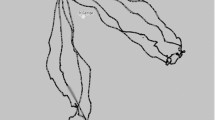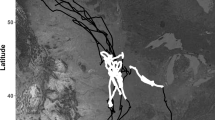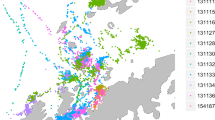Abstract
The analysis of animal movement and resource use has become a standard tool in the study of animal ecology. Telemetry devices have become quite sophisticated in terms of overall size and data collecting capacity. Statistical methods to analyze movement have responded, becoming ever more complex, often relying on state-space modeling. Estimation of movement metrics such as utilization distributions have not followed suit, relying primarily on kernel density estimation. Here we consider a method for making inference about space use that is free of all of the major problems associated with kernel density estimation of utilization distributions such as autocorrelation, irregular time gaps, and error in observed locations. Our proposed method is based on a data augmentation approach that defines use as a summary of the complete path of the animal which is only partially observed. We use a sample from the posterior distribution of the complete path to construct a posterior sample for the metric of interest. Three basic importance sampling based methods for sampling from the posterior distribution of the path are proposed and compared. We demonstrate the augmentation approach by estimating a spatial map of diving intensity for female northern fur seals in the Pribilof Islands, Alaska.
Similar content being viewed by others
References
Anderson-Sprecher, R., and Ledolter, J. (1991), “State-space Analysis of Wildlife Telemetry Data,” Journal of the American Statistical Association, 86, 596–602.
Blundell, G. M., Maier, J. A. K., and Debevec, E. M. (2001), “Linear Home Ranges: Effects of Smoothing, Sample Size, and Autocorrelation on Kernel Estimates,” Ecological Monographs, 71, 469–489.
CLS (2008), “Argos user’s manual,” http://www.argos-system.org/manual/.
de Jong, P., and Penzer, J. (1998), “Diagnosing Shocks in Time Series,” Journal of the American Statistical Association, 93, 796–806.
Durbin, J., and Koopman, S. (2001), Time Series Analysis by State Space Methods, Oxford: Oxford University Press. 253 pp.
— (2002), “A Simple and Efficient Simulation Smoother for State Space Time Series Analysis,” Biometrika, 89, 603–615.
Fieberg, J. (2007a), “Kernel Density Estimators of Home Range: Smoothing and the Autocorrelation Red Herring,” Ecology, 88, 1059–1066.
— (2007b), “Utilization Distribution Estimation Using Weighted Kernel Density Estimators,” Journal of Wildlife Management, 71, 1669–1675.
Givens, G., and Hoeting, J. A. (2005), Computational Statistics, New York: Wiley.
Goebel, M. E. (1998), “Female Foraging Behavior: Inter- and Intra-annual Variation in Individuals,” in Behavior and Ecology of the Northern Fur Seal, ed. R. Gentry, Princeton: Princeton University Press, pp. 243–259.
Gurarie, E., Andrews, R., and Laidre, K. (2009), “A Novel Method for Identifying Behavioural Changes in Animal Movement Data,” Ecology Letters, 12, 395–408.
Horne, J., and Garton, E. (2006), “Selecting the Best Home Range Model: An Information-Theoretic Approach,” Ecology, 87, 1146–1152.
Horne, J. S., Garton, E. O., Krone, S. M., and Lewis, J. S. (2007), “Analyzing Animal Movements Using Brownian Bridges,” Ecology, 88, 2354–2363.
Johnson, D. S., London, J. M., Lea, M.-A., and Durban, J. W. (2008), “Continuous-time Correlated Random Walk Model for Animal Telemetry Data,” Ecology, 89, 1208–1215.
Jonsen, I., Flemming, J., and Myers, R. (2005), “Robust State-space Modeling of Animal Movement Data,” Ecology, 86, 2874–2880.
Jonsen, I. D., Myers, R. A., and Flemming, J. M. (2003), “Meta-analysis of Animal Movement Using State-space Models,” Ecology, 84, 3005–3063.
Jonsen, I. D., Myers, R. A., and James, M. C. (2007), “Identifying Leatherback Turtle Foraging Behaviour from Satellite Telemetry Using a Switching State-space Model,” Marine Ecology-Progress Series, 337, 255–264.
Katajisto, J., and Moilanen, A. (2006), “Kernel-based Home Range Method for Data With Irregular Sampling Intervals,” Ecological Modelling, 194, 405–413.
Kuhn, C. E., Crocker, D. E., Tremblay, Y., and Costa, D. P. (2009a), “Time to Eat: Measurements of Feeding Behaviour in a Large Marine Predator, the Northern Elephant Seal Mirounga Angustirostris,” Journal of Animal Ecology, 78, 513–523.
Kuhn, C. E., Johnson, D. S., Ream, R. R., and Gelatt, T. S. (2009b), “Advances in the Tracking of Marine Species: Using GPS Locations to Evaluate Satellite Track Data and a Continuous-time Movement Model,” Marine Ecology Progress Series, 393, 97–109.
Morales, J. M., Haydon, D. T., Friar, J., Holsinger, K. E., and Fryxell, J. M. (2004), “Extracting More out of Location Data: Building Movement Models as Mixtures of Random Walks,” Ecology, 85, 2436–2445.
Otis, D. L., and White, G. C. (1999), “Autocorrelation of Location Estimates and the Analysis of Radiotracking Data,” Journal of Wildlife Management, 63, 1039–1044.
Patterson, T. A., Thomas, L., Wilcox, C., Ovaskainen, O., and Matthiopoulis, J. (2008), “State-space Models of Individual Animal Movement,” Trends in Ecology and Evolution, 23, 87–94.
R Development Core Team (2010), R: A Language and Environment for Statistical Computing, Vienna: R Foundation for Statistical Computing. http://www.R-project.org. ISBN 3-900051-07-0.
Rue, H., Martino, S., and Chopin, N. (2009), “Approximate Bayesian Inference for Latent Gaussian Models by Using Integrated Nested Laplace Approximations,” Journal of the Royal Statistical Society, Series B—Statistical Methodology, 71, 319–392.
Van Winkle, W. (1975), “Comparison of Several Probabilistic Home-range Models,” Journal of Wildlife Management, 39, 118–123.
Worton, B. J. (1989), “Kernel Methods for Estimating the Utilization Distribution in Home-range Studies,” Ecology, 70, 164–168.
Author information
Authors and Affiliations
Corresponding author
Rights and permissions
About this article
Cite this article
Johnson, D.S., London, J.M. & Kuhn, C.E. Bayesian Inference for Animal Space Use and Other Movement Metrics. JABES 16, 357–370 (2011). https://doi.org/10.1007/s13253-011-0056-8
Accepted:
Published:
Issue Date:
DOI: https://doi.org/10.1007/s13253-011-0056-8




